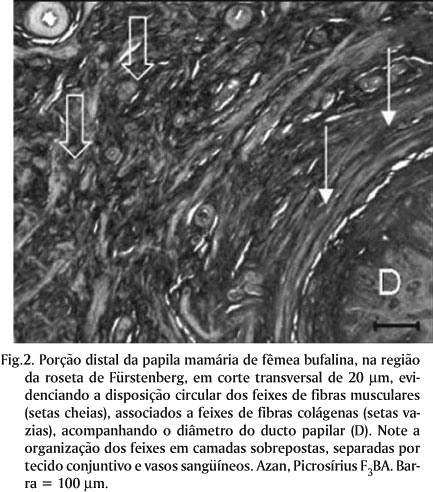Fifteen papillae from female water buffaloes and one bovine female were obtained in a slaughter house for this study, which consisted in morphologic and biometrical analyses, histology and histometric and mesoscopical analyses. The means were: right cranial papilla (RCP) 20.95g; right caudal papilla (RCaP) 21.49g; left cranial papilla (LCP) 23.52g; and left caudal papilla (LCaP) 21.35g. Papillary duct average length, numbers of folds and papillary cisterns length were, respectively: 0.67/5,5 e 2.17cm for RCP; 0.62/6.0 e 2.26cm for RCaP; and for the left antimere: RCP: 0.71/6.0 e 2.26cm and for RCaP: 0.74/5.7 e 2.57cm. Pearson's analysis revealed negative correlation between body weight and mammary glandular weight. Sampling of proximal, middle and distal area was taken and fixed into a 10% formaldehyde solution, followed by mesoscopical investigation through 10, 20 and 40µm thickness cuts stained by Azan, F3BA Picrosirus and Weigert-Van Gieson techniques. Histological and morphometric analyses were applied on 5µm thick samples and showed that the muscular layer was disposed into two arrangements, internal circular and external longitudinal with a bi-stratified cuboidal epithelium. A well developed muscular layer were related to the middle portion revealing thickness of 22.90mm with a great amount of connective tissue (7.10mm).
Buffaloes; mammary papilla; morphometry; morphology; Buballus bubalis









